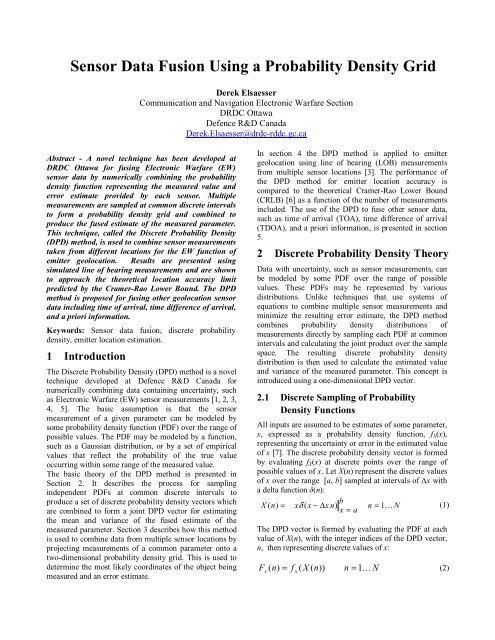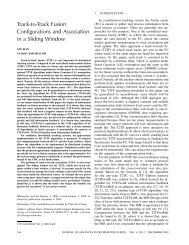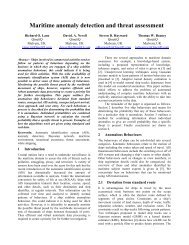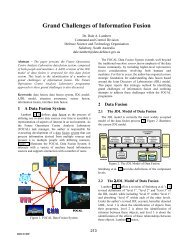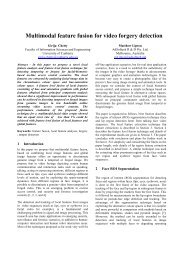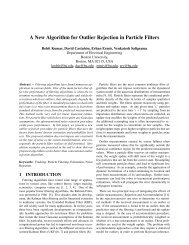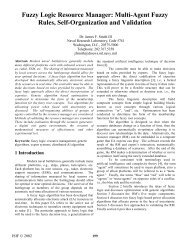Sensor Data Fusion Using a Probability Density Grid - ISIF
Sensor Data Fusion Using a Probability Density Grid - ISIF
Sensor Data Fusion Using a Probability Density Grid - ISIF
You also want an ePaper? Increase the reach of your titles
YUMPU automatically turns print PDFs into web optimized ePapers that Google loves.
<strong>Sensor</strong> <strong>Data</strong> <strong>Fusion</strong> <strong>Using</strong> a <strong>Probability</strong> <strong>Density</strong> <strong>Grid</strong><br />
Derek Elsaesser<br />
Communication and Navigation Electronic Warfare Section<br />
DRDC Ottawa<br />
Defence R&D Canada<br />
Derek.Elsaesser@drdc-rddc.gc.ca<br />
Abstract - A novel technique has been developed at<br />
DRDC Ottawa for fusing Electronic Warfare (EW)<br />
sensor data by numerically combining the probability<br />
density function representing the measured value and<br />
error estimate provided by each sensor. Multiple<br />
measurements are sampled at common discrete intervals<br />
to form a probability density grid and combined to<br />
produce the fused estimate of the measured parameter.<br />
This technique, called the Discrete <strong>Probability</strong> <strong>Density</strong><br />
(DPD) method, is used to combine sensor measurements<br />
taken from different locations for the EW function of<br />
emitter geolocation. Results are presented using<br />
simulated line of bearing measurements and are shown<br />
to approach the theoretical location accuracy limit<br />
predicted by the Cramer-Rao Lower Bound. The DPD<br />
method is proposed for fusing other geolocation sensor<br />
data including time of arrival, time difference of arrival,<br />
and a priori information.<br />
Keywords: <strong>Sensor</strong> data fusion, discrete probability<br />
density, emitter location estimation.<br />
1 Introduction<br />
The Discrete <strong>Probability</strong> <strong>Density</strong> (DPD) method is a novel<br />
technique developed at Defence R&D Canada for<br />
numerically combining data containing uncertainty, such<br />
as Electronic Warfare (EW) sensor measurements [1, 2, 3,<br />
4, 5]. The basic assumption is that the sensor<br />
measurement of a given parameter can be modeled by<br />
some probability density function (PDF) over the range of<br />
possible values. The PDF may be modeled by a function,<br />
such as a Gaussian distribution, or by a set of empirical<br />
values that reflect the probability of the true value<br />
occurring within some range of the measured value.<br />
The basic theory of the DPD method is presented in<br />
Section 2. It describes the process for sampling<br />
independent PDFs at common discrete intervals to<br />
produce a set of discrete probability density vectors which<br />
are combined to form a joint DPD vector for estimating<br />
the mean and variance of the fused estimate of the<br />
measured parameter. Section 3 describes how this method<br />
is used to combine data from multiple sensor locations by<br />
projecting measurements of a common parameter onto a<br />
two-dimensional probability density grid. This is used to<br />
determine the most likely coordinates of the object being<br />
measured and an error estimate.<br />
In section 4 the DPD method is applied to emitter<br />
geolocation using line of bearing (LOB) measurements<br />
from multiple sensor locations [3]. The performance of<br />
the DPD method for emitter location accuracy is<br />
compared to the theoretical Cramer-Rao Lower Bound<br />
(CRLB) [6] as a function of the number of measurements<br />
included. The use of the DPD to fuse other sensor data,<br />
such as time of arrival (TOA), time difference of arrival<br />
(TDOA), and a priori information, is presented in section<br />
5.<br />
2 Discrete <strong>Probability</strong> <strong>Density</strong> Theory<br />
<strong>Data</strong> with uncertainty, such as sensor measurements, can<br />
be modeled by some PDF over the range of possible<br />
values. These PDFs may be represented by various<br />
distributions. Unlike techniques that use systems of<br />
equations to combine multiple sensor measurements and<br />
minimize the resulting error estimate, the DPD method<br />
combines probability density distributions of<br />
measurements directly by sampling each PDF at common<br />
intervals and calculating the joint product over the sample<br />
space. The resulting discrete probability density<br />
distribution is then used to calculate the estimated value<br />
and variance of the measured parameter. This concept is<br />
introduced using a one-dimensional DPD vector.<br />
2.1 Discrete Sampling of <strong>Probability</strong><br />
<strong>Density</strong> Functions<br />
All inputs are assumed to be estimates of some parameter,<br />
x, expressed as a probability density function, f X (x),<br />
representing the uncertainty or error in the estimated value<br />
of x [7]. The discrete probability density vector is formed<br />
by evaluating f X (x) at discrete points over the range of<br />
possible values of x. Let X(n) represent the discrete values<br />
of x over the range [a, b] sampled at intervals of ∆x with<br />
a delta function δ(n):<br />
b<br />
X ( n)<br />
= xδ ( x − ∆x n)<br />
n = 1…<br />
N (1)<br />
x = a<br />
The DPD vector is formed by evaluating the PDF at each<br />
value of X(n), with the integer indices of the DPD vector,<br />
n, then representing discrete values of x:<br />
F ( n)<br />
= f ( X ( n))<br />
n = 1…<br />
N<br />
(2)<br />
x<br />
x
This requires the total area under f X (x) equals unity and the<br />
value of f X (x) > 0 over the range of possible values of x. If<br />
the value of the PDF is zero over some range of x, it<br />
implies that it is impossible for the measured value of x to<br />
occur in this range. As the DPD vector is produced by<br />
discrete sampling of a PDF, the DPD method is not reliant<br />
on a specific probability distribution and can be used with<br />
a variety of probability density distributions, including<br />
non-linear distributions.<br />
As an example of a DPD vector, consider the Gaussian<br />
PDF which is commonly used to represent sensor<br />
measurement errors that are normally distributed. It can be<br />
described by a mean, representing the estimated value,<br />
and variance, representing the uncertainty [4]. It can also<br />
be used in a system of equations representing the<br />
combination of multiple measurements for applications<br />
such as geolocation. A sensor measurement produces an<br />
estimate of x = 20 with a standard deviation of σ = 9.0.<br />
The Gaussian PDF is sampled over the range [-10, 50] at<br />
intervals of ∆x = 3.0. The continuous Gaussian PDF and<br />
the resulting DPD vector are shown in Figure 1. They are<br />
normalized over the range of x and the index, n, of F X (n)<br />
is translated back into x for comparison with f X (x).<br />
f(x), F(x)<br />
Continuous and Discrete Gaussian pdf; mean = 20.0, std = 9.0, dx = 3.0<br />
0.05<br />
continuous pdf<br />
0.045<br />
discrete pdf<br />
0.04<br />
0.035<br />
0.03<br />
0.025<br />
0.02<br />
0.015<br />
0.01<br />
0.005<br />
0<br />
-7 -4 -1 2 5 8 11 14 17 20 23 26 29 32 35 38 41 44 47 50<br />
x<br />
Figure 1. Discrete sampling of a Gaussian PDF<br />
2.2 Selecting a Sampling Interval<br />
Selection of an appropriate sampling interval, ∆x, is<br />
important as it directly impacts the computational cost of<br />
combining multiple measurements. In order to minimize<br />
the number of points, N, sampled over the range of x, the<br />
sampling interval must be selected so that the nature of the<br />
distribution of f X (x) is maintained by F X (n). As the aim is<br />
to determine the estimated value of x, x , and an error<br />
estimate in the form of the variance, σ 2 , about x , the<br />
sampling interval can be relatively large with respect to<br />
the variation in f X (x). For combining a set of Gaussian<br />
PDFs, a sampling interval of approximately σ i /2 (using the<br />
smallest value of σ i from the PDFs) has been found to be<br />
sufficient. Sampling at smaller intervals is generally found<br />
to have little effect on the resulting value of x and σ 2 , but<br />
increases computational cost proportionately with number<br />
of samples. Another factor to consider is the desired<br />
resolution of the resulting estimate of x . Because the<br />
index, n, of F X (n) is used to determine x , the sampling<br />
interval should be smaller than the desired resolution in x.<br />
2.3 Joint DPD Vectors<br />
A joint DPD vector is formed by taking the product of<br />
each input PDF at common sample points, X(n). For S<br />
sensor measurements this is expressed as:<br />
F ( s,<br />
n)<br />
= f ( s,<br />
X ( n))<br />
n = 1…<br />
N (3)<br />
x<br />
x<br />
where s = 1…S independent measurements of the same<br />
target; f X (s, x) is the array of PDFs representing these<br />
measurements over the same range [a, b] of x; and F X (s, n)<br />
is the resulting array of DPD vectors of length N. The<br />
joint discrete probability density vector, P X (n), is<br />
determined by taking the product of all DPD vectors at<br />
each integer value of n:<br />
S<br />
'<br />
PX<br />
( n)<br />
= ∏ FX<br />
( s,<br />
n)<br />
n = 1…<br />
N (4)<br />
s=<br />
1<br />
then calculating the normalization constant C:<br />
C =<br />
N<br />
∑<br />
n=<br />
1<br />
'<br />
P X<br />
( n)<br />
(5)<br />
resulting in the joint DPD vector:<br />
1 '<br />
PX<br />
( n)<br />
= PX<br />
( n)<br />
C<br />
n = 1…<br />
N (6)<br />
It is assumed that the chosen sampling interval is small<br />
enough to realize the significant variations in P X (n).<br />
The estimated value of the fused result is determined from<br />
the indices n weighted by P X (n):<br />
<br />
N<br />
n = ∑<br />
n=<br />
1<br />
nP n X<br />
( )<br />
and the estimated variance of n by:<br />
∑<br />
n=<br />
1<br />
(7)<br />
N<br />
2 2<br />
σ = ( n − n)<br />
P ( n)<br />
(8)<br />
n<br />
This is translated back into the domain of X within the<br />
range [a, b] giving the estimated value of x as:<br />
<br />
x = ∆xn<br />
+ a<br />
The standard deviation representing the combined error<br />
estimate is given by:<br />
σ = ∆<br />
(10)<br />
X<br />
xσ n<br />
X<br />
(9)
As the estimated value and error of the combined<br />
measurements, x andσ<br />
X<br />
, are produced by evaluating<br />
each PDF at discrete points, the DPD method can be used<br />
to combine measurements with different types of<br />
probability density distributions.<br />
2.4 Combining <strong>Sensor</strong> Measurements<br />
Benefits of the DPD method can be demonstrated by the<br />
following example, where the target value, x T =30, and<br />
each sensor measurement is modeled as a Gaussian PDF,<br />
PDF i (µ,σ), i = 1…3, with the mean being the measured<br />
value and the error estimate being the standard deviation.<br />
Note that each f X (x) must always be greater than 0. It is<br />
assumed that PDF 1 and PDF 3 represent accurate,<br />
unbiased, measurements of x T , but PDF 2 is a ‘wild’ or<br />
biased estimate. These three PDFs are shown in Figure 2,<br />
sampled at interval ∆x = 1.5 in Figure 3. The values of<br />
x and σ are calculated from the joint DPD vector shown<br />
X<br />
in Figure 4. It is seen that the inclusion of the biased<br />
measurement has only a modest effect on the resulting<br />
estimated value, x = 29.7, and error estimate, σ = 3.7.<br />
Gaussian(mean, std) for PDF1(30.0, 3.0), PDF2(11.5, 4.0), PDF3(30.5, 5.0)<br />
0.14<br />
PDF1<br />
PDF2<br />
0.12<br />
PDF3<br />
f(x)<br />
F(x)<br />
0.1<br />
0.08<br />
0.06<br />
0.04<br />
0.02<br />
0<br />
0 10 20 30 40 50 60<br />
x<br />
Figure 2. Three sensor measurements of x T = 30<br />
0.14<br />
0.12<br />
0.1<br />
0.08<br />
0.06<br />
0.04<br />
0.02<br />
0<br />
Discrete Sampling of Multiple PDFs, dx = 1.5<br />
6 12 18 24 30 36 42 48 54 60<br />
x<br />
X<br />
PDF1<br />
PDF2<br />
PDF3<br />
Figure 3. Discrete sampling of measurement PDFs<br />
P(x)<br />
0.25<br />
0.2<br />
0.15<br />
0.1<br />
0.05<br />
0<br />
Discrete Joint DPD, E[x] = 29.7, STD[x] = 3.7, dx = 1.5<br />
6 12 18 24 30 36 42 48 54 60<br />
x<br />
Figure 4. Joint DPD vector estimate of x T<br />
Numerous Monte Carlo simulations were conducted using<br />
combinations of various standard deviations, bias errors,<br />
and large numbers of measurements [2]. It was found that<br />
the joint DPD estimate generally converged on the true<br />
value as the number of measurements increased. It was<br />
also seen that the estimate was resilient to inclusion of<br />
measurements with large bias errors, with the main effect<br />
being an increase in the magnitude of the error estimate.<br />
3 Two Dimensional DPD <strong>Grid</strong>s<br />
A common data fusion function is to combine sensor<br />
measurements from multiple reference points to determine<br />
an estimate of the target in two or more dimensions. An<br />
example is emitter geolocation using LOB or TDOA<br />
measurements from multiple sensor positions [3]. The<br />
DPD method is applied by projecting the measurement<br />
PDF from each sensor onto a common grid of sample<br />
points. This requires that some transform function exists<br />
that will map the measured parameter into 2-dimenional<br />
space. This section describes using bearing measurements<br />
to produce a 2-dimensional location estimate.<br />
3.1 Projecting a LOB into Two Dimensions<br />
The Area-Of-Interest (AOI) that includes the target object<br />
is defined over a region in X and Y using a 2-dimenisonal<br />
grid of points at sample intervals ∆x and ∆y. It is implied<br />
that the target object is located within these bounds. The<br />
AOI must be large enough to ensure that truncation of the<br />
probability distribution at the boundaries does not<br />
significantly affect the result and that the sample interval<br />
is small enough to realize each PDF. Let there be S<br />
independent LOB measurements from sensor positions (x i ,<br />
y i ), i = 1…S, each with a measured bearing µ i and error<br />
estimate σ i . As bearing is an angular measurement, a LOB<br />
measurement can be represented by a von Mises PDF [7]:<br />
f ( θ ) = exp( κ cos( θ − µ )) / 2πI<br />
0<br />
( κ)<br />
0 ≤ θ < 2π<br />
(11)
where θ is the variable in radian, µ is the mean, κ is the<br />
concentration (which is analogous to 1/σ 2 ), and I 0 (κ ) is a<br />
Bessel function of the first kind and order zero. Examples<br />
of the von Mises PDF for LOBs with different values of κ<br />
are shown in Figure 5. Note that other probability density<br />
distributions can be used to model a LOB.<br />
0.16<br />
0.14<br />
Von Mises <strong>Probability</strong> <strong>Density</strong> Function<br />
LOB RMS error = 3 degrees, k = 364.7563<br />
LOB RMS error = 6 degrees, k = 91.1891<br />
LOB RMS error = 12 degrees, k = 22.7973<br />
An example of F XY (n,m) for a sensor at position (20, 20)<br />
with bearing estimate µ i = 45° and error estimate σ i = 3° is<br />
shown in Figure 7 as a color surface plot. It is seen that<br />
the value of F(x, y) is constant along any bearing line from<br />
the sensor, regardless of distance, since the value of the<br />
LOB PDF is constant for a given angle.<br />
0.12<br />
0.1<br />
p(angle)<br />
0.08<br />
0.06<br />
0.04<br />
0.02<br />
0<br />
-80 -60 -40 -20 0 20 40 60 80<br />
angle (degrees)<br />
Figure 5. The von Mises PDF used to model a LOB<br />
A transform is required to project the 1-dimensional LOB<br />
measurement, represented as an angular PDF, onto the 2-<br />
dimensional grid in X, Y. The value of the LOB PDF at<br />
each node in the grid is calculated using its angle relative<br />
to the sensor position. The angular transform function<br />
between the sensor location and a grid point is simply [5]:<br />
θ i ( x,<br />
y)<br />
= arctan(( y − y i ) /( x − x i )) − π ≤ θi<br />
< π (12)<br />
The value of a LOB PDF is calculated using the von<br />
Mises PDF with κ = 1/σ 2 for θ i (x, y) – µ i at each discrete<br />
point X(n) and Y(m), representing each (x, y) value in the<br />
grid, as shown in Figure 6.<br />
x i<br />
,y i<br />
x,y<br />
Figure 6. Transforming a LOB PDF to a 2-D DPD grid<br />
This produces a 2-dimensional LOB DPD array:<br />
F XY<br />
( n,<br />
m)<br />
= f ( θ ( X ( n),<br />
Y ( m)))<br />
n = 1... N , m = 1...<br />
M (13)<br />
i<br />
where F XY (n, m) is the LOB DPD array of size N×M<br />
points. The value of F XY (n, m) at a given index is the LOB<br />
PDF, f(θ i ), taken at discrete values of x, y.<br />
θ i<br />
µ i<br />
Figure 7. Example of a 2-D LOB DPD for µ=45˚, σ=3˚<br />
3.2 Joint DPD Location Estimate<br />
For multiple LOB measurements the joint DPD array is<br />
calculated over a common N×M grid by:<br />
S<br />
P<br />
'<br />
XY<br />
( n,<br />
m)<br />
= ∏ FXY<br />
( s,<br />
n,<br />
m)<br />
n = 1... N,<br />
m = 1...<br />
M<br />
s=<br />
1<br />
(14)<br />
where F XY (s, n, m) is the set of S independent LOB DPD<br />
arrays using a common grid. This is normalized by:<br />
N M<br />
C =<br />
'<br />
∑∑P<br />
( n,<br />
m)<br />
(15)<br />
XY<br />
n= 1m=<br />
1<br />
to produce the joint DPD array representing the target<br />
object’s location estimate:<br />
1 '<br />
PXY ( n,<br />
m)<br />
= PXY<br />
( n,<br />
m)<br />
(16)<br />
C<br />
For a grid of N by M points, the resulting computational<br />
complexity of the joint DPD array is of O(S×N×M).<br />
<br />
The 2-dimensional location estimate of the target, x T , yT<br />
,<br />
is determined by first taking the <strong>Probability</strong> Mass<br />
Functions (PMF) of P XY (n, m):<br />
X<br />
M<br />
XY<br />
m=<br />
1<br />
PMF ( n)<br />
= ∑ P ( n,<br />
m)<br />
n = 1... N (17)<br />
N<br />
XY<br />
n=<br />
1<br />
PMF ( m)<br />
= ∑ P ( n,<br />
m)<br />
m = 1... M (18)<br />
Y<br />
The target location estimate can be determined by treating<br />
PMF X (n) and PMF Y (m) as 1-dimensional DPD vectors and
calculating the index estimates, n ˆ , mˆ<br />
T T<br />
, as in equation 7.<br />
For cases where a large number of measurements<br />
correlate, the distribution of P XY (n,m) becomes<br />
exponential about the estimated location. The estimated<br />
location can then be found from the indices that have the<br />
largest values of PMF X (n) and PMF Y (m), respectively. As<br />
the indices are translated back into x and y coordinates to<br />
provide the location estimate of the target, this approach<br />
has the drawback that the resolution of the target location<br />
is limited to the sampling interval.<br />
The location error estimate is determined by the variances<br />
and covariance of the joint DPD array about the indices of<br />
estimated target location:<br />
COV<br />
XY<br />
N<br />
∑<br />
n=<br />
1<br />
2<br />
2<br />
σ = PMF ( n)<br />
⋅ ( n − nˆ<br />
) (19)<br />
X<br />
M<br />
∑<br />
m=<br />
1<br />
X<br />
2<br />
2<br />
σ = PMF ( m)<br />
⋅ ( m − mˆ<br />
) (20)<br />
N<br />
Y<br />
M<br />
= ∑∑<br />
n= 1 m=<br />
1<br />
P<br />
XY<br />
Y<br />
( n,<br />
m)<br />
⋅ ( n − nˆ<br />
) ⋅(<br />
m − mˆ<br />
)<br />
T<br />
T<br />
T<br />
T<br />
(21)<br />
These terms are scaled by the sampling interval and form<br />
a covariance matrix for calculating an Elliptical Error<br />
Probable (EEP), which is commonly used to represent the<br />
error estimate [3]. Although the EEP assumes that the<br />
error distribution is Gaussian, which may not be the case<br />
for a DPD distribution, it is useful for comparing the DPD<br />
results to other geolocation techniques and the CRLB. In<br />
cases where a sufficiently large number of measurements<br />
correlate near a point, the joint DPD distribution is seen to<br />
approximate a Gaussian distribution.<br />
4 DPD Method for LOB Geolocation<br />
LOB data is used for location estimation using the<br />
technique commonly referred to as triangulation. The<br />
DPD method is applied to LOB geolocation and compared<br />
to the CRLB, which represents the performance bound of<br />
an unbiased location estimator for the relative sensor<br />
positions and error estimates, excluding measurement<br />
biases. This is used to assess the accuracy of the DPD<br />
method and its resilience to bias errors.<br />
4.1 Increasing the Number of LOBs<br />
The comparison of the DPD method to the CRLB is<br />
conducted using Monte Carlo simulation and averaged<br />
over 10,000 iterations. All LOBs are normally distributed,<br />
with σ = 3˚, from 4 to 10 sensor sites arranged as a linear<br />
baseline across the bottom of an AOI. The details of the<br />
testing are provided in [2]. The AOI is defined as a<br />
200×300 point grid with a sampling interval of 100<br />
meters. The effect on the DPD location estimate is<br />
compared to the CRLB for an increasing number of<br />
unbiased LOBs with LOB1 having a bias error. This is<br />
repeated for bias errors on LOB1 of -40°, -20°, 0, 20°, and<br />
40° counterclockwise. An example for 10 LOBs and a 40°<br />
bias on LOB1 is shown in Figure 8. The location RMSE<br />
for increasing number of LOBs is shown in Figure 9.<br />
Location RMSE (m)<br />
Location RMSE (m)<br />
Location RMSE (m)<br />
Location RMSE (m)<br />
Location RMSE (m)<br />
Y x 100m<br />
300<br />
250<br />
200<br />
150<br />
100<br />
50<br />
Figure 8. Example scenario with LOB1 bias = 40°<br />
4000<br />
2000<br />
LOB STD = 3.0 deg, LOB1 Bias = -40.0 deg<br />
CRLB<br />
DPD Method<br />
0<br />
4 5 6 7 8 9 10<br />
Number of LOBs included in fix<br />
LOB STD = 3.0 deg, LOB1 Bias = -20.0 deg<br />
4000<br />
2000<br />
CRLB<br />
DPD Method<br />
0<br />
4 5 6 7 8 9 10<br />
Number of LOBs included in fix<br />
LOB STD = 3.0 deg, LOB1 Bias = 0.0 deg<br />
4000<br />
2000<br />
CRLB<br />
DPD Method<br />
0<br />
4 5 6 7 8 9 10<br />
Number of LOBs included in fix<br />
LOB STD = 3.0 deg, LOB1 Bias = 20.0 deg<br />
4000<br />
2000<br />
CRLB<br />
DPD Method<br />
0<br />
4 5 6 7 8 9 10<br />
Number of LOBs included in fix<br />
LOB STD = 3.0 deg, LOB1 Bias = 40.0 deg<br />
4000<br />
2000<br />
DPD Location Estimate and CRLB<br />
LOB1<br />
DPD<br />
CRLB<br />
1 5 7 2 9 10 3 8 6 4<br />
20 40 60 80 100 120 140 160 180 200<br />
X x 100m<br />
CRLB<br />
DPD Method<br />
0<br />
4 5 6 7 8 9 10<br />
Number of LOBs included in fix<br />
Figure 9. Effect if increasing the number of unbiased<br />
LOBs with LOB1 bias error = -40°, -20°, 0°, 20°, 40°.
It is seen that the inclusion of the biased LOB from site 1<br />
has limited effect on the DPD location estimate. Even for<br />
the worst-case, a LOB1 bias error of 20˚, the location<br />
RMSE for the DPD method approaches the CRLB as the<br />
number of unbiased LOBs is increased. Even though the<br />
location RMSE for the DPD method is still larger than the<br />
CRLB, it must be remembered that the CRLB represents<br />
the ideal estimate with no bias errors.<br />
The DPD location error estimate (the EEP) also decreased<br />
as the number of LOBs increased [2]. This suggests that<br />
the DPD method is an unbiased location estimator, even in<br />
the presence of unknown sensor bias errors. Other tests<br />
have shown that the DPD method is resilient to large<br />
numbers of bias errors because the joint DPD distribution<br />
is determined mainly by measurements that correlate near<br />
the most common location [1]. This makes the DPD<br />
method well suited to real-world applications where<br />
sensor measurements are often affected by environmental<br />
conditions or systemic errors.<br />
5 Other Geolocation Techniques<br />
The DPD method may be applied to other geolocation<br />
techniques based on the measurement of parameters such<br />
as time, frequency, or power. Time is used in TOA<br />
techniques such as radar and range estimation for signals<br />
with known timing characteristics. TDOA between<br />
multiple sites is a common technique for geolocation of<br />
non-cooperative signals. The measured receive power of a<br />
signal can be used to estimate range if sufficient detail is<br />
known of the transmitted power and propagation path.<br />
Any of these techniques can be used in a hybrid method<br />
with LOBs. Because each technique relies on a<br />
measurement of a parameter with various degrees of error,<br />
it can be modeled with some PDF; hence, the DPD<br />
method could be used to produce a location estimate. This<br />
section shows how the DPD method is applied to timebased<br />
measurements and hybrid techniques using a priori<br />
information.<br />
5.1 Time Of Arrival Location Estimation<br />
In TOA, the measured parameter is the time between<br />
when the signal was emitted and when it was received at<br />
the sensor (or half the transit time in the case of radar<br />
signals). If the speed of signal propagation, υ, is known,<br />
the TOA from any point to sensor i can be calculated by:<br />
toa<br />
d<br />
v<br />
1<br />
v<br />
2<br />
2<br />
i<br />
( x,<br />
y)<br />
= = ( y − yi<br />
) + ( x − xi<br />
) (22)<br />
If the sampling interval is constant in x, y, a TOA<br />
measurement for sensor s can be transformed into a 2-<br />
dimensional TOA DPD array by evaluating the PDF at<br />
each discrete node:<br />
F ( n,<br />
m)<br />
= f ( toas ( X ( n),<br />
Y(<br />
m)))<br />
n = 1... N,<br />
m = 1...<br />
M (24)<br />
s s<br />
The joint DPD array is calculated by taking the product of<br />
all S sensor measurement DPD arrays at each common<br />
node, n, m:<br />
S<br />
P(<br />
n,<br />
m)<br />
= ∏ F(<br />
s,<br />
n,<br />
m)<br />
n = 1... N,<br />
m = 1... M<br />
s=<br />
1<br />
(25)<br />
Consider the following example for TOA geolocation.<br />
There are four sensors deployed in a 2 km × 2 km AOI<br />
and the target emitter is located in the center of the AOI as<br />
shown in Figure 10.<br />
Y (meters)<br />
2000<br />
1800<br />
1600<br />
1400<br />
1200<br />
1000<br />
800<br />
600<br />
400<br />
200<br />
1<br />
TOA Scenario<br />
200 400 600 800 1000 1200 1400 1600 1800 2000<br />
X (meters)<br />
Figure 10. Scenario for TOA location estimation<br />
Each sensor has the ability to estimate the TOA with a<br />
standard deviation of 200 ns. The PDF is assumed to be<br />
Gaussian with the mean being the actual transit time of the<br />
signal. The desired location resolution is 10 meters<br />
(sample interval = 10 meters). A TOA DPD array from<br />
sensor 1, with no bias errors or multi-path effects, is<br />
shown in Figure 11. Similar DPD arrays are produced for<br />
the TOA measurements from the other sensors and a Joint<br />
DPD array is produced. The location estimate is<br />
calculated as in section 3 and shown in Figure 12.<br />
2<br />
4<br />
3<br />
The measurement of the TOA can be modeled by a PDF,<br />
such as a Gaussian distribution with the estimated TOA<br />
being the mean, µ, and estimated error as the standard<br />
deviation, σ:<br />
2 2<br />
exp( −(<br />
toa − µ ) ) /(2σ<br />
))<br />
f ( toa)<br />
=<br />
(23)<br />
2πσ
in a non-Gaussian distribution of the joint DPD peak and a<br />
smaller EEP ellipse. The truncation of the DPD peak is<br />
equivalent to using the bounds of the AOI as a priori<br />
information, as discussed next.<br />
Figure 11. TOA DPD grid for sensor 1 at (50,100)<br />
2000<br />
TOA DPD 50% EEP: 1000.0,1000.0m 50.1x50.1m @ 90.0 deg<br />
Y (meters)<br />
1800<br />
1600<br />
1400<br />
1200<br />
1000<br />
800<br />
600<br />
400<br />
200<br />
1<br />
Target<br />
EEP<br />
200 400 600 800 1000 1200 1400 1600 1800 2000<br />
X (meters)<br />
Figure 12. TOA scenario with target location estimate<br />
5.2 Time Difference Of Arrival<br />
The DPD method can also be used to provide location<br />
estimates from TDOA data, where the emission time of<br />
the signal is unknown but the relative time difference of<br />
arrival of the signal between pairs of sensors can be<br />
measured. Like TOA, the TDOA PDF can be represented<br />
by a Gaussian function, as shown in equation 23, with the<br />
TDOA value being the difference of the TOA value from<br />
each node in the grid to a given pair of sensors.<br />
Consider an example using the same sensor deployment<br />
scenario as shown in Figure 10 with the target emitter<br />
located at grid (160,160), and a TDOA measurement<br />
error, σ TDOA = 282.8 ns. The four sensors provide six<br />
TDOA measurement pairs that are shown in Figure 13 to<br />
visualize the joint probability density grid, which is seen<br />
to exhibit some truncation at the boundary. This results in<br />
the major axis of the resulting DPD EEP being slightly<br />
smaller than the CRLB, as shown in Figure 14.<br />
The estimated location of the target is unaffected by the<br />
truncation of the DPD distribution; however, the variance<br />
calculations are limited to the points in the grid, resulting<br />
2<br />
4<br />
3<br />
Y (meters)<br />
Figure 13. TDOA DPD grid for target at (160,160)<br />
TDOA DPD 50% EEP: 1600.0,1600.0m 318.1x64.2m @ 45.0 deg<br />
2000<br />
1800<br />
1600<br />
1400<br />
1200<br />
1000<br />
800<br />
600<br />
400<br />
200<br />
DPD (red)<br />
200 400 600 800 1000 1200 1400 1600 1800 2000<br />
X (meters)<br />
Figure 14. Effect of truncation on DPD location estimate<br />
5.3 <strong>Fusion</strong> of a Priori Information<br />
CRLB (black)<br />
It is implicit in the definition of the boundaries of the AOI<br />
that the probability the target resides outside the AOI is<br />
negligible. Hence, it can be argued that this truncation<br />
represents the product of the sensor measurements with a<br />
priori knowledge of the target’s possible location. This<br />
concept could be extended to include other a priori<br />
information, such as terrain data, that could be represented<br />
as a DPD distribution. For example, if the target emitter is<br />
known to be mounted on a vehicle, then a street map<br />
could be used as a priori information and modeled by a<br />
DPD distribution, as shown in Figure 15, with a relatively<br />
high probability the target in on a street and relatively low<br />
probability it is located elsewhere.
Figure 15. <strong>Using</strong> a street map DPD as a priori information<br />
When the TDOA DPD grid shown in Figure 13 is<br />
combined with the street map DPD grid, the result is the<br />
improved location estimate shown in Figure 16.<br />
Y (meters)<br />
TDOA-MAP DPD 50% EEP: 1600.0,1600.0m 92.4x21.2m @ 45.0 deg<br />
2000<br />
1800<br />
1600<br />
1400<br />
1200<br />
1000<br />
800<br />
600<br />
400<br />
200<br />
200 400 600 800 1000 1200 1400 1600 1800 2000<br />
X (meters)<br />
Figure 16. Improved location estimate using map<br />
This illustrates that DPD grid can be used to represent a<br />
variety of types of data and information that have some<br />
degree of uncertainty. The nature of the probability<br />
density distribution can be almost any form as long as it is<br />
non-zero at all points and normalized over the AOI.<br />
Multiple probability density distributions can be combined<br />
directly, regardless of the source, as long as they are<br />
projected onto a common grid.<br />
6 Conclusion<br />
TDOA-MAP FIX<br />
The DPD method is useful for a variety of applications as<br />
it does not require sensor measurement errors to be<br />
normally distributed. Research suggests that the DPD<br />
method is an unbiased estimator that provides a<br />
maximum-likelihood solution for geolocation. This is<br />
achieved at the cost of computational complexity, which<br />
is of O(S×N×M) for S sensor measurements over an N×M<br />
grid.<br />
The DPD method has been demonstrated for geolocation<br />
in two dimensions using line of bearing, time of arrival,<br />
time difference of arrival, and hybrid methods [1]. It can<br />
easily incorporate a priori information in the form of nonlinear<br />
data including geo-spatial data such as street maps.<br />
It is expected that the DPD method can be extended to<br />
provide 3-dimensional location estimates and used with<br />
other geolocation techniques and data.<br />
The DPD method is well suited for geolocation<br />
applications involving large numbers of measurements<br />
from different sensors that experience significant errors.<br />
This includes urban environments with large multi-path<br />
effects, or sensors mounted on mobile platforms having<br />
significant positional and orientation errors, such as land<br />
combat vehicles or a small aircraft. Future research<br />
includes characterization of the DPD method and its<br />
application to other geolocation and data fusion problems,<br />
including the use of geographic information.<br />
References<br />
[1] Derek Elsaesser, The Discrete <strong>Probability</strong> <strong>Density</strong><br />
Method For Electronic Warfare <strong>Sensor</strong> <strong>Data</strong> <strong>Fusion</strong>,<br />
DRDC Ottawa TR 2006-242, Defence R&D Canada –<br />
Ottawa, November 2006.<br />
[2] Derek Elsaesser, The Discrete <strong>Probability</strong> <strong>Density</strong><br />
Method For Emitter Geolocation, Canadian Conference<br />
on Electrical and Computer Engineering 2006,<br />
Conference proceedings (ISBN: 1-4244-0038-4), Ottawa,<br />
Ontario, 7-10 May 2006.<br />
[3] Richard A. Poisel, Electronic Warfare Target<br />
Location Methods. “The Discrete <strong>Probability</strong> <strong>Density</strong><br />
Method,” Artech House, Boston, MA, 2005, pp.72-79.<br />
[4] Derek Elsaesser and Richard Brown, “The Discrete<br />
<strong>Probability</strong> <strong>Density</strong> Method for Emitter Geo-Location,”<br />
DRDC Ottawa TM 2003-068, Defence R&D Canada –<br />
Ottawa, June 2003.<br />
[5] Richard Brown and Derek Elsaesser, “<strong>Probability</strong><br />
<strong>Grid</strong> and Contours for Estimating Radar Locations,”<br />
DREO TM 2000-095, Defence R&D Canada – Ottawa,<br />
November 2000.<br />
[6] Don Torrieri, “Statistical Theory of Passive Location<br />
Systems,” IEEE Transactions on Aerospace and<br />
Electronic Systems, VOL AES-20, No. 2, pp. 183-198,<br />
March, 1984.<br />
[7] Edward Emond, “A New Mathematical Approach to<br />
Direction Finding,” Project Report No. PR505,<br />
Operational Research and Analysis Establishment,<br />
Directorate of Mathematics and Statistics, Department of<br />
National Defence, Canada, 1989.


